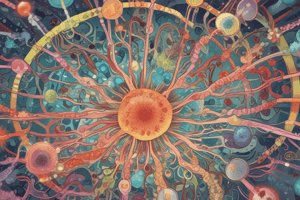Podcast
Questions and Answers
Which cytosolic proteins sense viral RNA and induce the production of antiviral cytokines?
Which cytosolic proteins sense viral RNA and induce the production of antiviral cytokines?
- dsRNA and IL-1β
- RLRs and IFNs
- RIG-I and MDA-5 (correct)
- MAVS and NLRP3
What is required to initiate signaling events that activate transcription factors for the production of type I IFNs?
What is required to initiate signaling events that activate transcription factors for the production of type I IFNs?
- Pattern recognition receptor signaling
- Mitochondrial antiviral-signaling (MAVS) (correct)
- Pro–interleukin-1β (pro–IL-1β)
- Inflammasome
What is responsible for processing pro–interleukin-1β (pro–IL-1β) to active IL-1β?
What is responsible for processing pro–interleukin-1β (pro–IL-1β) to active IL-1β?
- NLRP3 inflammasome (correct)
- RIG-like receptors (RLRs)
- Mitochondrial antiviral-signaling (MAVS)
- Pattern recognition receptor signaling
What do RLRs recognize in viral RNAs that are not typical of mammalian RNA?
What do RLRs recognize in viral RNAs that are not typical of mammalian RNA?
Which receptor recognizes cytosolic viral RNA and triggers antiviral cytokine type I interferon (IFN) production?
Which receptor recognizes cytosolic viral RNA and triggers antiviral cytokine type I interferon (IFN) production?
Which pathway do most innate cytosolic DNA sensors engage to induce type I IFN production?
Which pathway do most innate cytosolic DNA sensors engage to induce type I IFN production?
Which molecule binds to STING, leading to type I IFN gene expression?
Which molecule binds to STING, leading to type I IFN gene expression?
Which receptor type is involved in the phagocytosis of fungi and bacteria?
Which receptor type is involved in the phagocytosis of fungi and bacteria?
$ ext{Formyl peptide receptor 1}$ is expressed mainly on which type of cells?
$ ext{Formyl peptide receptor 1}$ is expressed mainly on which type of cells?
$ ext{Inflammasome}$ stimulates the production of which active cytokine closely related to IL-1?
$ ext{Inflammasome}$ stimulates the production of which active cytokine closely related to IL-1?
Which molecule directly sensed by STING stimulates autophagy and lysosomal degradation of pathogens?
Which molecule directly sensed by STING stimulates autophagy and lysosomal degradation of pathogens?
Which circulating molecules provide defense against microbes in the innate immune system?
Which circulating molecules provide defense against microbes in the innate immune system?
Which sensor recognizes microbial dsDNA in the cytosol and activates signaling pathways?
Which sensor recognizes microbial dsDNA in the cytosol and activates signaling pathways?
Which receptors are involved in innate immune responses to microbes apart from NLRP1, NLRC4, or AIM2?
Which receptors are involved in innate immune responses to microbes apart from NLRP1, NLRC4, or AIM2?
Which form of inflammasome contains sensors NLRP1, NLRC4, or AIM2?
Which form of inflammasome contains sensors NLRP1, NLRC4, or AIM2?
Flashcards are hidden until you start studying
Study Notes
Innate Immune Responses to Microbes
- Inflammasome stimulates production of active IL-18, closely related to IL-1, and other forms exist containing sensors NLRP1, NLRC4, or AIM2
- Mechanism of acute inflammation involves pathogenic bacteria and ATP entering plasma membrane, leading to formation of NLRP3 inflammasome
- Cytosolic DNA sensors recognize microbial dsDNA in cytosol and activate signaling pathways, also recognizing self DNA
- Cytosolic RIG-like receptors (RIG-I and MDA5) recognize cytosolic viral RNA, triggering antiviral cytokine type I interferon (IFN) production
- Most innate cytosolic DNA sensors engage the stimulator of IFN genes (STING) pathway to induce type I IFN production
- Cytosolic dsDNA binds to cGAS, activating production of cyclic GMP-AMP (cGAMP) that binds to STING, leading to type I IFN gene expression
- Bacterial second messenger molecules (c-di-GMP and c-di-AMP) are directly sensed by STING, stimulating autophagy and lysosomal degradation of pathogens
- Viruses and bacteria lead to DNA activation of cGAS and cyclic dinucleotides, followed by activation of IRF3, TBK1, and STING bound together on the surface of ER
- Many other receptor types are involved in innate immune responses to microbes, such as lectins and formyl peptide receptor 1
- Lectins in the plasma membrane, like dectins and mannose receptors, are involved in phagocytosis of fungi and bacteria
- Formyl peptide receptor 1, expressed mainly on phagocytes, recognizes bacterial proteins and promotes migration and antimicrobial activities of phagocytes
- The innate immune system also contains several circulating molecules that recognize and provide defense against microbes
Studying That Suits You
Use AI to generate personalized quizzes and flashcards to suit your learning preferences.





